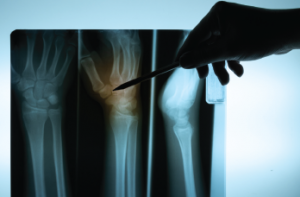
alice-photo / shutterstock.com
Imagine leaving the hospital after suffering a heart attack without being treated for hypertension or being started on a beta blocker. What would we think of the hospital where patients are never educated about the relationship between treating hypertension and reducing myocardial infarction and stroke risk?
Unfortunately, this happens every day with osteoporosis and fractures in health systems around the world. Just as the link between untreated hypertension and myocardial infarction is undeniable, so is the knowledge that osteoporosis leads to fractures. Given its high prevalence, the potential for high costs passed on to patients and the health system overall, and the availability of drugs to treat and prevent fractures, osteoporosis should be considered an enormous public health concern.
In the U.S. and Europe, it is estimated that approximately 30% of postmenopausal women have osteoporosis. Forty percent of these women will suffer at least one fragility fracture in their lifetime, and having an initial fragility fracture increases the risk of sustaining a new fracture by about 85%.1
Despite these astounding figures, diagnosis and treatment of osteoporosis remains low among physicians worldwide. As of 2016, the percentage of postmenopausal women being screened for osteoporosis in the U.S. was 41.9%, well below the national average for breast cancer screening (72.7%) and beta blocker treatment after a myocardial infarction (84.4%).2
Even after patients are admitted and treated for non-traumatic fragility fractures, the osteoporosis management rate remains very low. One retrospective study found that treatment was prescribed in only 44% of cases after a vertebral fracture and only 21% of cases after a proximal femur fracture.3
Rheumatology Initiatives in Fracture Liaison Services
The abysmal rate of treatment after the sentinel event of first osteoporotic fracture makes this an area ripe for improvement. A Fracture Liaison Service (FLS) is a means to improve secondary prevention of osteoporotic fractures. The National Osteoporosis Foundation (NOF) recognizes the FLS as a means to improve outcomes related to secondary prevention of fractures.4
Geisinger Health System (GHS) was one of the first health systems to develop an FLS in the U.S. The GHS High Risk Osteoporosis Clinic was developed in 1996. It is a program headed by the Division of Rheumatology and uses osteoporosis management guidelines to help improve osteoporosis diagnosis and treatment.5 GHS was able to decrease hip fracture rates, increase the number of patients who receive a dual-energy X-ray absorptiometry (DXA) scan and increase the number of patients who received treatment.5
Just as the link between untreated hypertension & myocardial infarction is undeniable, so is the knowledge that osteoporosis leads to fractures.
In a similar effort, the Division of Rheumatology at Loma Linda University Health (LLUH), California, spearheaded a project to create an FLS in partnership with the Departments of Endocrinology, Orthopedic Surgery, and Geriatrics. An LLUH needs-assessment study showed that up to 90% of patients admitted to the hospital for a fracture in this medically underserved region of the Inland Empire of Southern California were not being initiated on treatment for osteoporosis subsequent to discharge. Notably, at least 40% of patients had come in for a second fracture.6
Fracture Liaison Services are essential to increase the detection and treatment rate of osteoporosis. They streamline the connection between the inpatient and outpatient settings, as well as provide intervention at a critical point in the care of osteoporotic patients. Based on LLUH’s experience, it is crucial to create an easy manner for orthopedic surgery and hospitalist services to consult the FLS through an order set when admitting a patient for a fragility fracture.
During the inpatient encounter, the FLS can coordinate and schedule an outpatient follow-up appointment in the osteoporosis clinic with an endocrinologist or a rheumatologist. In addition, the patient is given an appointment for an outpatient DXA scan, and their vitamin D level is measured—satisfying Medicare hospital requirements to provide post-fracture care.
In addition, the FLS has enhanced postgraduate education. Residents rotate on the Fracture Liaison Service while on their endocrinology and rheumatology rotations and are provided workshops on DXA interpretation. Multidisciplinary monthly meetings on various topics related to osteoporosis management and secondary causes of osteoporosis enhance the rotation and serve to keep rheumatologists, endocrinologists and geriatricians apprised of the latest advances in osteoporosis care.
FLS programs can also be run by other specialties. The Southern California Kaiser Permanente Healthy Bones Program is one of the more established Fracture Liaison Services in the country. The Healthy Bones program was developed by orthopedist Richard O’Dell, MD, in 2011.7 Between 2002 and 2007, DXA scans increased 263%, the number of patients receiving anti-osteoporosis treatment increased 153%, and the overall hip fracture rate was reduced by 38.1%.8
Kaiser Permanente is a closed health system with its own insurance product, an advantageous position to be in when effecting change. The Healthy Bones Program, in part, can attribute some level of success to ease of transitions across healthcare systems owing to its all in-network group of providers, as well as uniform insurance packages where DXA scans are known to be covered.
GHS and LLUH, on the other hand, are open health systems where primary care providers may be located out of network and myriad insurance plans are in play, some of which may not cover DXA scans, or access to a covered DXA facility may not be within driving distance of a patient. Due to dwindling reimbursement, access to DXA scans nationwide is a well-recognized problem.
System Challenges
Diagnosing osteoporosis and getting patients to believe in and commit to a treatment plan pose many challenges. Many patients do not believe they have suffered a fracture due to osteoporosis and place the blame entirely on the low level of trauma that preceded the fracture. In the care of medically complex patients, precious clinic time is often diverted toward seemingly more pressing health conditions, such as diabetes, hypertension and cardiovascular disease. The beauty of an FLS is the diagnosis is already made; patients who suffer an osteoporotic fracture need osteoporosis treatment.
James Larsen, MD, a geriatrician at LLUH, laments over the issue of non-
adherence. He notes that at our institution, “there is no problem getting patients screened for osteoporosis; the problem is getting patients committed to treatment. Patients are worried about the side effects of treatment.”
His concerns echo studies showing that since 2002 a decline in prescribing rates for bisphosphonates has corresponded with a profound increase in fragility fractures among women.9 The risks of atypical femur fractures and osteonecrosis of the jaw with the use of bisphosphonates have been overly emphasized by the media, drowning out the loss of independence, infection and mortality that can follow immobility from fractures.
There is hope. The National Osteoporosis Foundation (NOF) has played an instrumental part in fighting osteoporosis nationally by providing education to health professionals and the general public. In addition to raising awareness of the scope of the problem, the NOF takes a stand to help eliminate it by providing health professionals training and certification in Fracture Liaison Services. The NOF also offers guidance on diagnostic assessment, monitoring and pharmacologic treatment in its Clinician’s Guide for Treatment of Osteoporosis, published and updated since 1999.4
At Loma Linda University Health System, the FLS improves the rates of screening and diagnosis prior to a fracture, decreases the incidence of refracture and increases awareness of the consequences of osteoporosis among patients and primary care physicians. The goal is to bring the national average for appropriate post-fracture osteoporosis management to the level of breast cancer screening and beta blocker treatment after a myocardial infarction.
Imagine that.
 Micah Yu, MD, is a rheumatology fellow at Loma Linda University, Calif.
Micah Yu, MD, is a rheumatology fellow at Loma Linda University, Calif.
 Anna Lafian, DO, is a rheumatology fellow at Loma Linda University, Calif.
Anna Lafian, DO, is a rheumatology fellow at Loma Linda University, Calif.
 Christina Downey, MD, RhMSUS, CCD, is an assistant professor of medicine in the Division of Rheumatology at Loma Linda University, Calif.
Christina Downey, MD, RhMSUS, CCD, is an assistant professor of medicine in the Division of Rheumatology at Loma Linda University, Calif.
References
- Facts and statistics. International Osteoporosis Foundation.
- State of health care quality. National Committee for Quality Assurance.
- Andrade SE, Majumdar SR, Chan KA, et al. Low frequency of treatment of osteoporosis among postmenopausal women following a fracture. Arch Intern Med. 2003 Sep 22;163(17):2052–2057.
- Trippe KA. Clinical updates: Closing the gap—Preventing recurrent fractures. National Osteoporosis Foundation. 2018 Mar 27.
- Newman ED. Perspectives on pre-fracture intervention strategies: The Geisinger Health System Osteoporosis Program. Osteoporos Int. 2011 Aug;22(Suppl 3):451–455.
- Yu M, Suh J, Nedley A, et al. Fracture Liaison Service at Loma Linda University: Why there is a real need [abstract]. Osteoporosis Symposium: Innovations in Bone Health Care. Loma Linda, Calif. 2018 May.
- Dell R. Fracture prevention in Kaiser Permanente Southern California. Osteoporosis Int. 2011 Aug;22(Suppl 3):457–460.
- Dell R, Greene D, Schelkun SR, Williams K. Osteoporosis disease management: The role of the orthopaedic surgeon. J Bone Joint Surg. 2008 Nov;90(Suppl 4):188–194.
- Solomon DH, Johnston SS, Boytsov NN, et al. Osteoporosis medication use after hip fracture in US patients between 2002 and 2011. J Bone Miner Res. 2014 Sep;29(9):1929–1937.
